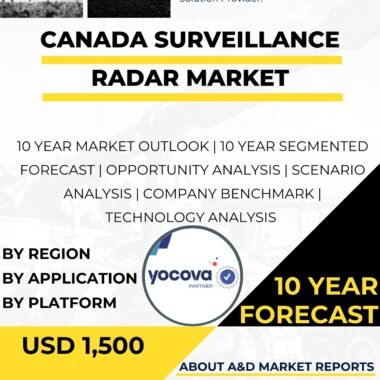Description
The surveillance radar market in Japan has witnessed significant growth and strategic importance as the nation seeks to enhance its airspace surveillance, maritime domain awareness, and early warning capabilities. Surveillance radars play a crucial role in modernizing Japan’s defense and security forces, enabling them to detect and track airborne and maritime threats, safeguard national airspace, and respond effectively to potential security challenges.
The surveillance radar market in Japan encompasses a diverse range of radar systems, including air surveillance radars, maritime surveillance radars, and early warning radars. These radar systems are deployed at various locations across the country, including military bases, coastal areas, and critical infrastructure, providing Japan with comprehensive surveillance coverage and enhancing its situational awareness.
One of the primary applications of surveillance radars in Japan is in enhancing its airspace surveillance and air defense capabilities. Air surveillance radars are deployed to detect and track airborne threats, including aircraft, drones, and missiles, providing early warning to Japan’s Air Self-Defense Force (JASDF) and enabling them to respond rapidly to potential airspace violations or security threats.
Moreover, surveillance radars contribute significantly to Japan’s maritime domain awareness and coastal surveillance efforts. Maritime surveillance radars are utilized to monitor vessel movements, detect potential intrusions into territorial waters, and enhance Japan’s maritime security. These radars support the Japan Coast Guard and maritime authorities in safeguarding the nation’s waters and responding to maritime incidents effectively.
Furthermore, early warning radars play a crucial role in Japan’s national security strategy. These radars are designed to provide early detection and tracking of ballistic missile threats, offering essential seconds or minutes for response and countermeasures. Early warning radars form a critical component of Japan’s ballistic missile defense system, enhancing its deterrence posture and contributing to regional stability.
As Japan emphasizes indigenous defense capabilities, the domestic production and development of surveillance radars have seen substantial growth. Collaborations between the government, defense industry, and research institutions have fostered innovation, leading to the creation of advanced radar systems tailored to Japan’s specific defense and security requirements.
Japan’s alliance with the United States has also played a significant role in the development of its surveillance radar capabilities. Through this partnership, Japan has access to advanced radar technologies, expertise, and support, contributing to the modernization of its defense and security forces and enhancing interoperability with allied nations.
The surveillance radar market in Japan also benefits from advancements in radar technology, signal processing, and radar network integration. Manufacturers have leveraged these developments to create surveillance radars with improved detection range, accuracy, and target tracking capabilities, making them more effective and adaptable to evolving security challenges.
However, the surveillance radar market in Japan also faces challenges related to airspace congestion, radar coverage gaps, and electromagnetic spectrum management. Ensuring comprehensive airspace surveillance requires effective radar coverage over vast territories and congested airspace. Addressing these challenges requires the deployment of radar systems at strategic locations and the use of radar network integration to enhance surveillance coverage.
Moreover, radar coverage gaps, particularly in mountainous and remote areas, pose challenges to effective surveillance and early warning capabilities. Addressing these gaps may require the use of alternative surveillance technologies, such as unmanned aerial systems (UAS) or space-based sensors.
Additionally, managing electromagnetic spectrum allocation is crucial for minimizing interference and optimizing radar performance. Coordinating radar frequencies and managing electromagnetic spectrum usage are essential for ensuring radar reliability and reducing the risk of signal jamming or interference.
In conclusion, the surveillance radar market in Japan has witnessed significant growth and strategic importance, driven by the nation’s focus on enhancing its airspace surveillance, maritime domain awareness, and early warning capabilities. Surveillance radars provide critical solutions for airspace surveillance, maritime security, and early warning, catering to Japan’s specific defense and security requirements. The collaboration between the government, defense industry, and research institutions, as well as international partnerships with allied nations, fosters innovation and contributes to the growth of the domestic surveillance radar market. Addressing challenges related to airspace congestion, radar coverage gaps, and electromagnetic spectrum management is crucial for further enhancing Japan’s surveillance radar capabilities and ensuring that its defense and security forces remain equipped with advanced and reliable radar systems to effectively safeguard its airspace, maritime interests, and national security. With its strategic focus on indigenous defense capabilities, Japan remains committed to leveraging advanced surveillance radar technologies to enhance its surveillance capabilities, maintain situational awareness, and contribute to regional and global security efforts.




